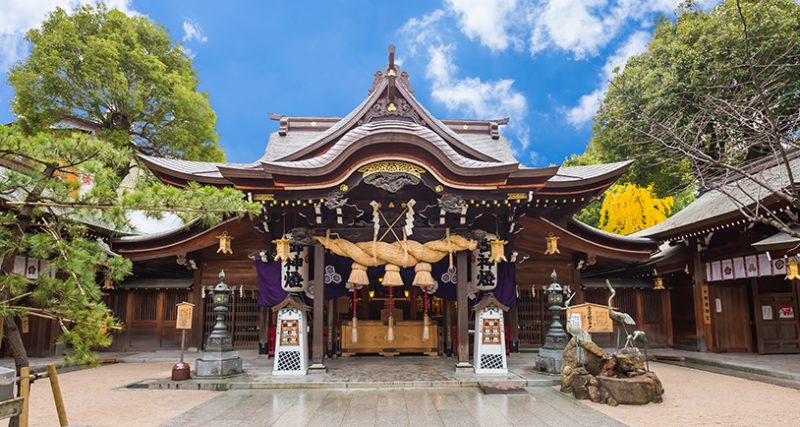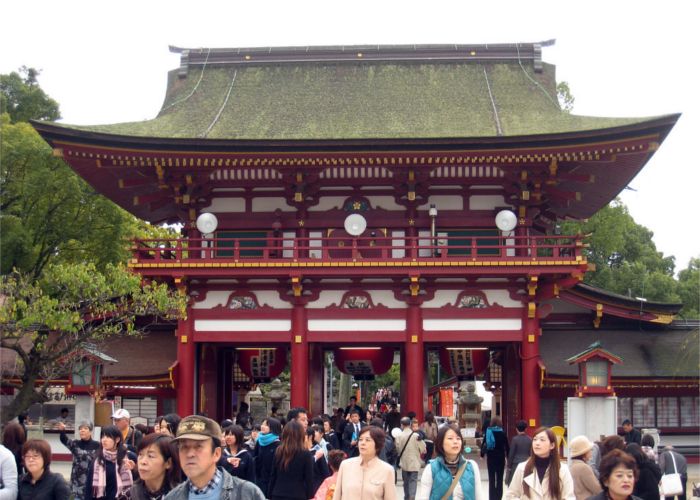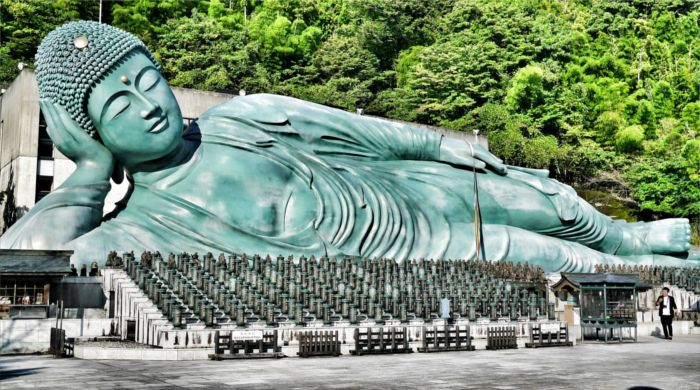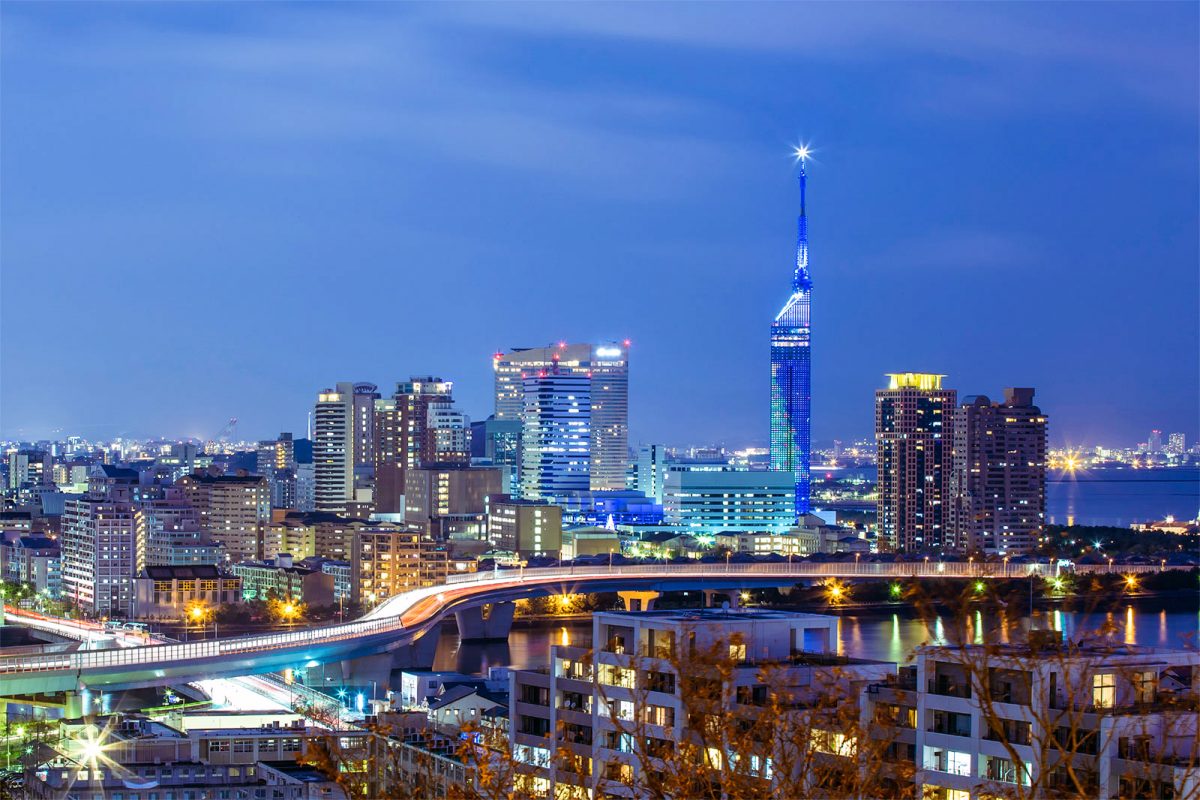The city of Fukuoka is one of the main tourist destinations in southern Japan. It’s the largest city on the island of Kyushu, and is a must-see for travelers visiting the region.
Fukuoka is known for its cultural landmarks and events, including Japan’s largest wooden Great Buddha statue, and the UNESCO-listed Hakata Gion Yamakasa float festival, which takes place every July.
At a 5-hour distance from Tokyo by Shinkansen, many visitors choose to make Fukuoka a key stop on their itinerary. This guide explains the best ways to get to Fukuoka and the top attractions to see on your visit.
Table of Contents
How To Get to Fukuoka
Getting to Fukuoka is simple, thanks to the city’s key transport hubs, like Hakata Station. It’s the largest station in the region and has two Shinkansen bullet train lines.
It’s the Northern terminus station for the Kyushu Shinkansen, which connects Fukuoka with Kagoshima-Chuo. Hakata is also the Western terminus station of the Sanyo Shinkansen, which connects to Osaka.
Fukuoka is also well connected for air passengers. Hakata Station is less than 2 miles from Fukuoka Airport (FUK), which carries international and domestic flights.
Tokyo to Fukuoka by train
To get from Tokyo to Fukuoka, first take the Tokaido Shinkansen to Shin-Osaka Station, where you will transfer trains before continuing to Hakata Station. This leg of the journey takes between 2.5 and 4 hours, depending on which type of train you take. In order to use your JR Pass, ride either the a Hikari or Kodama train.
There are 2 to 3 departures per hour of Hikari and Kodama trains for Shin-Osaka. Non-reserved seat tickets for Hikari trains are around ¥13,900 for an almost 3-hour journey. The fee is similar for Kodama trains, but the journey takes around 3 hours and 4 minutes.
Next, take the Sanyo Shinkansen to Hakata Station. It takes around 2.5 hours to reach Fukuoka if you take one of the faster services on this line. Sakura trains are covered by the JR Pass, but other fast lines, like the Nozomi or Mizuho require a supplementary ticket.
Sakura trains depart for Fukuoka from Shin-Osaka approximately once or twice per hour. If you’re traveling without a JR Pass, a non-reserved seat ticket for this service is around ¥14,800.
Kyoto to Fukuoka
Much like travelers coming from Tokyo, you take the Tokaido and Sanyo Shinkansen trains to reach Fukuoka from Kyoto.
All services on the Tokaido bullet line from Kyoto take around 12 minutes to Shin-Osaka. If you’re using a JR Pass, take a Hikari or Kodama train to avoid paying a supplementary ticket fee. Two to four trains on these services depart per hour.
When you arrive at Osaka, change to the Sanyo bullet line and take a Sakura service to Hakata Station with your JR Pass. There’s at least one train on this service per hour, from around 6:00 a.m. to 8:00 p.m.
Sakura trains take 2.5 hours to Fukuoka. Other services are available, but they have a longer journey time, or require an extra ticket purchase. Without a JR Pass, ticket prices from Kyoto to Fukuoka average around ¥16,000.
Osaka to Fukuoka
If you’re traveling from Osaka, you can reach Fukuoka with just one train. You can board a Sanyo Shinkansen train at Shin-Osaka Station, with multiple departures per hour.
The fastest services (Nozomi and Mizuho) require JR Pass holders to buy an add-on ticket for around ¥5,000. If you take a Sakura service (2.5 hours), or Kodama service (4 hours), there’s no need to pay the supplement fee.
Things To Do in Fukuoka
Modern day Fukuoka is made up of Hakata, an international trading port since the 8th century, and Fukuoka, the castle town built around the samurai stronghold from the 1600s.
Though the city is renowned for its key historical and cultural sites, in more recent years, it’s also become known as one of Japan’s leading ‘Startup Cities’. This is thanks to its growing clean energy innovation and technology sectors.
That’s what makes Fukuoka the perfect mix between the old and new, meaning there’s plenty to see and do during your visit.
If you’re planning your itinerary and wondering what to do in Fukuoka, here are some of the top attractions and best places to visit.

Sample new tastes at Yatai food stalls
Fukuoka is well known for its yatai, small open-air food stalls. The tradition dates back to the postwar period, when street vendors began setting up portable kitchens to serve street food and quick, affordable meals.
Today, around 100 yatai can still be found across the city, especially in areas like Nakasu and Tenjin. You can reach them by subway from Hakata Station in around 10 minutes.
From stand to stand, you’ll find people sampling ramen, yakitori, oden, gyoza, and many others. Each stall has its own specialties, including traditional Japanese staples and local dishes. Most have regular customers, giving them a friendly and social spirit that’s welcoming to visitors.
Observe worshipers at the Dazaifu Tenmangu Shrine
Dazaifu is one of Japan’s most important Tenmangu Shrines, located around 40 minutes from Fukuoka City. To get there, take the Nishitetsu train from Fukuoka Tenjin Station to Dazaifu Station, with one easy transfer at Futsukaichi.

Tenmangu Shrines are dedicated to Sugawara Michizane, a scholar and politician of the Heian Period who is associated with Tenjin (the Shinto deity of education). Hiss career was remarkable and his influence quickly grew until he was head of the Fujiwara clan.
Following exile by his rivals, Michizane died in 903 and shortly after the country was hit by a string of natural disasters.
People thought the spirit of Michizane was responsible for disasters so they began building shrines and making offerings to calm his vengeful spirit. Dazaifu is built on the site of his grave.
Reflect on the Nanzoin Temple reclining Buddha
Nanzoin Temple is famous for its giant, bronze, reclining Buddha and its connection to the Sasaguri Pilgrimage. The site is located in the Sasaguri area of the Fukuoka Prefecture, around 20 minutes from the city.
To get there, take the JR Fukuhoku Yutaka Line from Hakata Station to Kido Nanzoin-mae Station. The temple is just a short walk from the station.
The site’s giant Buddha (known as Nehanzo) is 135 feet long, 36 feet tall, and weighs roughly 300 tons. It was built in 1995 to house the ashes of the Buddha and two of his followers, Ananda and Maudgalyayana.

Most Buddha statues in Japan show him sitting in meditation, but the one at Nanzo-in Temple is reclining. This pose represents the moment the Buddha entered Nirvana, or final peace. It’s not a common sight in Japan, which is a key reason why this site is so significant.
When visiting the statue, visitors are meant to hold the colored ropes which hang from the bronze statue’s left hand and say a prayer. It’s also considered lucky to place a coin on the decorations.
Join in the fun at Nintendo Fukuoka
Nintendo Fukuoka will open at the end of 2025 as Japan’s fourth official Nintendo store. It’ll be located in AMU Plaza Hakata, part of the JR Hakata City complex, directly connected to JR Hakata Station.
Much like its sister stores, Nintendo Fukuoka will feature displays of Nintendo’s most popular franchises, including Super Mario, Zelda, and Pokémon. It’ll also be a place to pick up consoles and software, as well as character-themed goods.
Keep an eye out for announcements from Nintendo about their new store.
